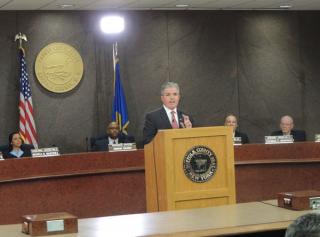Address Highlights Water Quality & Economic Development as Priorities for the County; Bellone: We need to ‘Reclaim our Water’ together
(Hauppauge, NY) Last night, County Executive Steve Bellone delivered his third State of the County address to a packed room at the William H. Rodgers Legislative Building in Hauppauge.
During his address, Bellone prioritized the imperative need to focus on threats to Suffolk County’s water quality from failing septic tanks and cesspools.
“There is no greater challenge to our future than the water quality crisis that we must now begin to confront as a County. Nitrogen poisoning of our surface and ground waters is the greatest crisis this County has faced in a generation,” said County Executive Bellone. “Clean water should be the birthright of every Long Islander, and it’s time we tackle this crisis together and Reclaim Our Water.”
Bellone cited nitrogen pollution as “public water enemy #1”, the effects of which have damaged coastal wetlands – the last line of defense against massive weather systems like Superstorm Sandy.
“In the wake of Sandy, we understand that pollution into the Great South Bay, which primarily enters through river corridors, has eroded our coastal defenses and left us more vulnerable to storm damage,” said Bellone. “Rebuilding these coastal defenses, in addition to the important work we must undertake to secure our barrier islands through the Fire Island to Montauk Point Reformulation Plan is critical to protecting our communities. Every level of government must come together to rebuild the dunes on Fire Island as quickly as possible.”
Bellone stated, “Based on scientific research and Governor Cuomo’s NYS 2100 Commission, we know that tidal wetlands play a critical role in slowing waves and protecting communities from storm damage. Yet in the Great South Bay, we have lost most of our natural defenses and sustained nitrogen pollution means that we are unable to rebuild them. Studies show that we lost approximately half the wetlands in the Great South Bay between 1954 and 2001 and conditions have only worsened since then.”
In order to rebuild coastal protections and rebuild wetlands, experts state strides to reduce nitrogen, which flows each day into the Great South Bay, must be undertaken. The County is currently developing a comprehensive plan to expand sewering which will directly reduce the nitrogen pollution in our waterways.
Bellone outlined a number of concrete steps the County will take to address the water quality crisis:
The County will create a roadmap to solve the problem that analyzes, on a household-by-household basis, which homes should be sewered, which homes need improved single-home systems and which homes can be a part of neighborhood clustered projects. The criteria used in this analysis will include: groundwater and surface water modeling, proximity to existing wastewater infrastructure, soil conditions, depth to groundwater, and other factors to guide decisions to make the best possible investments in waste water treatment going forward.
Bellone has directed the Suffolk County Department of Health to give manufacturers throughout the nation the opportunity to demonstrate single-home wastewater treatment system technologies in Suffolk County—at no cost to taxpayers— in an effort to test these systems in local conditions and approve systems by the end of 2014.
The County is also finalizing criteria through the Suffolk County Sewer Infrastructure Committee to initiate projects for the installation of community-scale innovative alternative systems which can serve clusters of between 50 and 100 homes. As these systems and technologies are tested, we will ensure that not only are they addressing the need to reduce nitrogen, but also other emerging water threats, like pharmaceuticals.
“This is a year of action for our water,” stated County Executive Bellone. “By the end of this year, we will have firmly identified the scope of the problem, begun work to sewer critical areas, have a clear roadmap as to what type of technology we need for every impacted home, and will begin to roll out technologies to place in those identified homes.”
In addition, Bellone highlighted strides made in economic development initiatives and the need to do more to reverse the Brain Drain that has plagued our region for more than 20 years.
“You cannot build a strong economy with broad based prosperity if you cannot retain or attract young, high-skilled, high-knowledge workers,” stated County Executive Bellone.
Connect LI – County Executive’s plan to invest in a modern public transportation system that connects major downtowns, job centers, universities, parks, research centers and hubs that young people want easy and convenient access to.
Transient Oriented Downtowns – Suffolk County has made progress on downtown revitalization efforts and laid the groundwork for projects -Wyandanch Rising, Ronkonkoma hub, Heartland project, East End transportation plan)
Since 2012, the IDA has closed on 24 projects which represent 4,300 jobs retained, 1,400 new jobs created, $43 million in payroll into our local economy and $232 million in new capital investment. In the two years prior to 2012, the IDA only closed on 5 projects.
Lastly, County Executive Bellone discussed his continued efforts to make government more efficient and more effective. These efforts include a commitment to stay under Governor Cuomo’s property tax cap, improving the permitting processes, and maintaining a lean County government workforce by eliminating redundancies.
“In Suffolk County government today the great dividing line is between those who stand for government reform and those who seek to protect the status quo,” stated Bellone.
Bellone stressed the importance of giving Suffolk County voters the right to decide whether the elected offices of Comptroller and Treasurer should be consolidated into a single elected office.
“As you can imagine, the current system is inefficient, and by consolidating these offices, we can eliminate patronage positions, make government more efficient and save taxpayer money,”
In addition to addressing Suffolk County’s long-term water quality, infrastructure and fiscal interests, County Executive Bellone focused on addressing regional and social issues, such as prescription drug addiction, prisoner recidivism, and expanding opportunities for our growingly diverse county of 1.5 million people.

